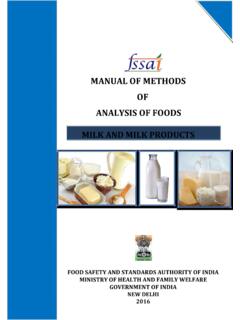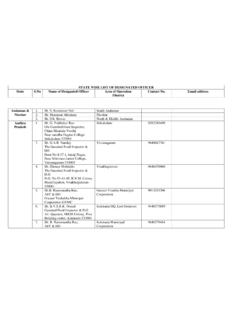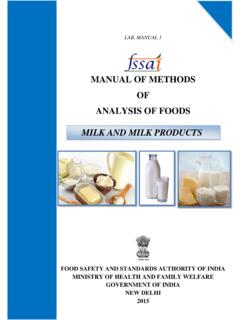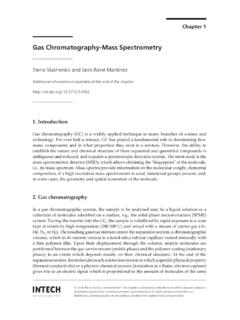Transcription of MANUAL OF METHODS OF ANALYSIS OF FOODS - FSSAI
1 LAB. MANUAL 11 MANUAL OF METHODS OF ANALYSIS OF FOODS FOOD SAFETY AND STANDARDS AUTHORITY OF INDIA MINISTRY OF HEALTH AND FAMILY WELFARE GOVERNMENT OF INDIA NEW DELHI 2015 PESTICIDE RESIDUES Endosulphan DDT ACKNOWLEDGEMENT Deepest Sense of Gratitude and Indebtedness to all the Members of the Panel Method of Sampling and ANALYSIS and Experts, who have helped, supported knowledge and insight, have led the successful completion of Revision of manuals. Sincere Thanks to the Panel, Chairman for his valuable guidance, and encouragement and the Secretariat of this panel who have worked hard throughout the tenure of revision work. Deepest Appreciation to the Chairperson, FSSAI and CEO, FSSAI for the cooperation, support and constant encouragement, without which the work would not have seen the light of day. ** PESTICIDE RESIDUES 2015 1 MANUAL FOR ANALYSIS OF PESTICIDE RESIDUE IN FOODS TABLE OF CONTENTS TITLE PAGE NO.
2 1 Codex Guidelines on Good Practice in Pesticide Residue ANALYSIS 5 2 Sample Collection 16 3 Reporting Analytical Results 22 4 Pesticide Standards 28 5 Purification of Solvents and Reagents 31 6 extraction and Clean-Up METHODS in Pesticide Residue ANALYSIS 35 7 Multi Residue Method for Determination of Chlorinated Pesticide 43 i) Dichlorodiphenyltrichloroethane ii) HCH iii) Endosulphan iv) Aldrin v) Dieldrin vi) Chlordane vii) Heptachlor 8 Multi Residue Method for Determination of Organo-Phosphorus Pesticides 57 i) Acephate ii) Chlorpyriphos iii) Chlorpyriphos-methyl iv) Demeton-O v) Diazinon vi) Dimethoate vii) Ethion viii) Fenitrothion ix) Malaoxan x) Malathion xi) Mathamidophos xii) Monocrotophos xiii) Omethoate xiv) Paraoxon xv) Paraoxon-Methyl xvi) Parathion xvii) Parathion-Methyl xviii) Phosalone xix) Pirimiphos-Methyl 9 Multiresidue Gas chromatography Method for Synthetic Pyrethroids 63 i) Bifenthrin ii) Fenopropathrin iii) Cyhalothrin iv) Permethrin PESTICIDE RESIDUES 2015 2 v) Cypermethrin vi) Fluvalinate vii) Fenvalerate viii) Deltamethrin 10 Multiresidue Method of N-Methylcarbamate Insecticides 67 i) Carbaryl ii) Carbofuron 11 Multiple Residue Method for Fumigants 71 i) Ethylene Dibromide ii) Carbon Tetrachloride iii) Methyl Bromide iv) Phosphine 12 Thiamethoxam 78 13 Thiodicarb/Methomyl 85 14 Cymoxanil 90 15 Multiresidue Gas Chromatographic Method for Determination of Organochlorine and Pyrethroid pesticides in Milk, Fish and Eggs 94 i) Dichlorodiphenyltrichloroethane ii) HCH iii) Endosulphan iv) Aldrin v) Dieldrin vi) Chlordane vii) Heptachlor viii) Dicofol ix) Cyhlalothrin x) Permethrin xi) Cypermethrin xii) Fenvalerate xiii)
3 Deltamethrin 16 Acetamiprid 99 17 Imidacloprid 103 18 Pretilachlor 109 19 Isoprothiolane 114 20 Fosetyl 120 21 Propiconazole 127 22 Dithiocarbamates 132 (i) Ferbam (ii) Ziram (iii) Thiram (iv) Maneb (v)Zineb (vi)Mancozab (vii) Nabam 23 Ethylene Thiourea and Ethylene Urea 140 24 Tricyclazole 143 25 Triadimefon and Triadimenol 147 26 Metalaxyl 153 PESTICIDE RESIDUES 2015 3 27 Triazole Fungicides 157 i) Hexaconazole ii) Propiconazole iii) Penconazole iv) Myclobutanil v) Triademifon vi) Bitertanol 28 Chlorsulfuron and Metasulfuron 164 29 Anilophos 170 30 Diclofop-Methyl 173 31 Glufosinate 173 32 Linuron 190 33 Diquat and Paraquat 195 34 Atrazine and Simazine 198 35 Metribuzin 203 36 2, 4-D 208 37 Pendimethalin Analytical METHODS of Pesticide Residues in Water 213 38 Organochlorine Pesticides in Water by Gas Chromatographic Method 216 i) Aldrin ii) - BHC iii) - BHC iv) - BHC v) - BHC vi) - chlordane vii) - chlordane viii) 4,4'- ODD ix) 4,4'- DDE x) 4,4'- Dichlorodiphenyltrichloroethane xi) Dieldrin xii) Endosulfan I xiii) Endosulfan II xiv) Endosulfan Sulphate xv) Heptachlor xvi) Heptachlor Expoxide 39 N-Methylcarbamoylomimes and N-Methlycarbamates in Finished Drinking Water 224 i) Aldicrab ii) Aldicarb Sulfone iii) Aldicarb Sulfoxide iv) Baygon v) Carbaryl vi) Carboftiron vii) 3-hydroxycarboruron viii) Methiocarb ix) Methomyl x)
4 Oxamyl 40 Determinatin of Alachlor, Atrazine and Butachlor in Water 230 PESTICIDE RESIDUES 2015 4 41 Determination of 2,4-D in Drinking Water by liquid - liquid Microextraction, derivatization , and Fast Gas chromatography with electron capture detection 240 42 Determination of Isoproturon in Water by Solid-Phase extraction and liquid chromatography 247 43 Nitrogen and Phosphorus Containing Pesticides in Finished Drinking Water 249 (i) Dichlorvos (ii) Phorate (iii) Chlorpyrifos. Methyl (iv) Chlopyrifos (v) Monocrotophos (vi) Dimethoate (vii) Malathion (viii) Parathion, Methyl (ix) Parathion, Ethyl (x) Ethion (xi) Phosphamidon (xii) Atrazine (xiii) Simazine 44 Laboratory Safety 256 PESTICIDE RESIDUES 2015 5 1. CODEX GUIDELINES ON GOOD PRACTICE IN PESTICIDE RESIDUE ANALYSIS Introduction The Codex document ALINORM 76/24 Appendix IV (Report of the ad hoc Working Group on METHODS of ANALYSIS ) contained the following statement: "It was considered that the ultimate goal in fair practice in international trade depended, among other things, on the reliability of analytical results.
5 This in turn, particularly in pesticide residue ANALYSIS , depended not only on the availability of reliable analytical METHODS , but also on the experience of the analyst and on the maintenance of good practice in the ANALYSIS of pesticides. These guidelines define such good analytical practice and may be considered in three inter-related parts: The Analyst Basic Resources The ANALYSIS The Analyst Residue ANALYSIS consists of a chain of procedures, most of which are known, or readily understood, by a trained chemist, but because the analyst concentrations are in the range g/kg to mg/kg and because the ANALYSIS can be challenging, attention to detail is essential. The analyst in charge should have an appropriate professional qualification and be experienced and competent in residue ANALYSIS . Staff must be fully trained and experienced in the correct use of apparatus and in appropriate laboratory skills.
6 The analyst can use the method within the expected performance parameters established during method validation prior to ANALYSIS of samples. They must have an understanding of the principles of pesticide residue ANALYSIS and the requirements of Analytical Quality Assurance (AQA) systems. They must understand the purpose of each stage in the method, PESTICIDE RESIDUES 2015 6 the importance of following the METHODS exactly as described and of nothing any unavoidable deviations. They must also be trained in the evaluation and interpretation of the data they produce. A record of training and experience must be kept for all laboratory staff. When a laboratory for residue ANALYSIS is set up, the staff should spend some of their training period in a well established laboratory where experienced advice and training is available.
7 If the laboratory is to be involved in the ANALYSIS for a wide range of pesticide residues, it may be necessary for the staff to gain experience in more than one expert laboratory. Basic Resources laboratory The laboratory and its facilities must be designed to allow tasks to be allocated to well-defined areas where maximum safety and minimum chance of contamination of samples prevail. Laboratories should be constructed of, and utilise materials resistant to chemicals likely to be used within them. Under ideal conditions, separate rooms would be designated for sample receipt and storage, for sample preparation, for extraction and clean-up and for instrumentation used in the determinative step. The area used for extraction and clean-up must meet solvent laboratory specifications and all fume extraction facilities must be of high quality.
8 Simple receipt, storage and preparation should be handled in areas devoted to work at residue levels. Maintenance of sample integrity and adequate provisions for personal safety for priority requirements. Laboratory safety must also be considered in terms of what is essential and what is preferable, as it must be recognised that the stringent working conditions enforced in residue laboratories in some parts of the world could be totally unrealistic in others. No smoking, eating, drinking or application of cosmetics should be permitted in the working area. Only small volumes of solvents should be held in the working area and the bulk of the solvents stored separately, away from the main working area. The use of highly toxic solvents and reagents should be minimised whenever possible. All waste solvent should PESTICIDE RESIDUES 2015 7 be stored safely and disposed of both safely and in an environmentally friendly manner taking into account specific national regulations where available.
9 The main working area should be designed and equipped for utilisation of an appropriate range of analytical solvents. All equipment such as macerators and refrigerators should be spark free or explosion proof. extraction , clean-up and concentration steps should be carried out in a well ventilated area, preferably in fume cupboards. Safety screens should be used when glassware is used under vacuum or pressure. There should be an ample supply of safety glasses, gloves and other protective clothing, emergency washing facilities and a spillage treatment kit. Adequate fire fighting equipment must be available. Staff must be aware that many pesticides have acutely or chronically toxic properties and therefore, great care is necessary in the handling of standard reference compounds. Equipment and Supplies The laboratory will require adequate, reliable, supplies of electricity and water.
10 Adequate supplies of reagents, solvents, gas, glassware, chromatographic materials etc. of suitable quality are essential. Chromatographic equipment, balances, spectrophotometers etc. must be serviced and calibrated regularly and a record of all servicing/repairs must be maintained for every such item of equipment. Calibration is essential for equipment including glassware performing measurements. Calibration curves and comparison with standards may suffice. Regular calbration and re-calibration of measuring equipment must be done where the possible change in nominal value may significantly contribute to the uncertainty of the measurement. Balances and automated pipettes/dispensers and similar equipment must be calibrated regularly. The operating temperatures of refrigerators and freezers should be continually monitored or be checked at specified intervals.









